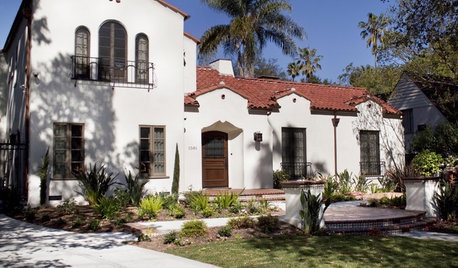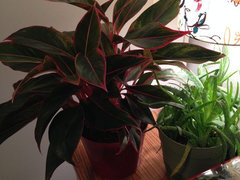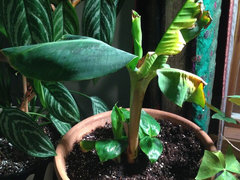Please identify possible pest?
blytheinspired
8 years ago
Featured Answer
Sort by:Oldest
Comments (48)
tropicofcancer (6b SW-PA)
8 years agotapla (mid-Michigan, USDA z5b-6a)
8 years agoRelated Discussions
Please identify this rose pest (pic)
Comments (8)I'd also say that poor thing did not do the damage to your rose buds. That looks like some kind of wasp and it was probably hunting the bug that did do the damage. There are a lot of wasps in all different sizes, from miniscule on up to the relatively gigantic tarantula hawks. Most eat other insects, the smaller ones by laying their eggs in caterpillars, to be eaten from the inside while still alive; the larger ones by carrying caterpillars back to their nest to be eaten in a more conventional manner. Kstrong, I'm surprised you have to protect your monarch caterpillars?? I thought they're poisonous. Maybe that's just to birds and the predatory wasps aren't affected?...See MorePlease Help Identify Pest/Disease on Blackberry Leaves
Comments (7)wind.. high winds flap the leaves around.. and they shred themselves on their own thorns ... when jean suggested mechanical.. most of us read that to mean.. IGNORE IT ... there is nothing to do.. and as a newbie.. do understand.. that leaves take a heck of a beating over the season.. and do not look martha stewart perfect all year long ... the leaf is green.. and still functioning.. there is nothing for you to do.. nor worry about.. ken...See Moreplease identify this pest (and please excuse 'test' post)
Comments (3)It is quite similar to cottony cushion scale, going by the photos that I found online, but it doesn't seem to be exactly the same. Obviously it is a scale of some sort that is a close relative. Thanks....See MorePossible Pest ID, Please
Comments (3)It is scale and generally control measures are necessary. Unless you use a systemic control, you will need to make repeated applications because they can be difficult to eradicate. A horticultural oil should do the trick. The best control can be had while the scale is in the "crawler" phase, and they are so small then, you likely won't be able to see them crawling on the leaves (they are tiny specks). So don't miss the repeat applications per the oil's instructions, should you choose to use oil. It also helps to control the small ant population at the same time, because it is not uncommon for ants to feed on the honeydew and protect the scale from natural predators....See Moretropicofcancer (6b SW-PA)
8 years agolast modified: 8 years agotapla (mid-Michigan, USDA z5b-6a)
8 years agolast modified: 8 years agoblytheinspired
8 years agoMrBlubs
8 years agolast modified: 8 years agotropicofcancer (6b SW-PA)
8 years agotapla (mid-Michigan, USDA z5b-6a)
8 years agolast modified: 8 years agoblytheinspired thanked tapla (mid-Michigan, USDA z5b-6a)blytheinspired
8 years agotapla (mid-Michigan, USDA z5b-6a)
8 years agoblytheinspired
8 years agoblytheinspired
8 years agotapla (mid-Michigan, USDA z5b-6a)
8 years agolast modified: 8 years agoaruzinsky
8 years agolast modified: 8 years agoblytheinspired
8 years agoblytheinspired
8 years agoblytheinspired
8 years agoblytheinspired
8 years agoblytheinspired
8 years agoblytheinspired
8 years agotropicofcancer (6b SW-PA)
8 years agoaruzinsky
8 years agotropicofcancer (6b SW-PA)
8 years agotapla (mid-Michigan, USDA z5b-6a)
8 years agolast modified: 8 years agoblytheinspired thanked tapla (mid-Michigan, USDA z5b-6a)aruzinsky
8 years agolast modified: 8 years agoaruzinsky
8 years agolast modified: 8 years agotropicofcancer (6b SW-PA)
8 years agolast modified: 8 years agoMrBlubs
8 years agoaruzinsky
8 years agorina_Ontario,Canada 5a
8 years agotropicbreezent
8 years agotropicofcancer (6b SW-PA)
8 years agotapla (mid-Michigan, USDA z5b-6a)
8 years agoaruzinsky
8 years agolast modified: 8 years agoaruzinsky
8 years agolast modified: 8 years agoblytheinspired
8 years agoaruzinsky
8 years agolast modified: 8 years agotapla (mid-Michigan, USDA z5b-6a)
8 years agoaruzinsky
8 years agotapla (mid-Michigan, USDA z5b-6a)
8 years agotropicofcancer (6b SW-PA)
8 years agoblytheinspired
8 years ago
Related Stories

SUMMER GARDENINGHouzz Call: Please Show Us Your Summer Garden!
Share pictures of your home and yard this summer — we’d love to feature them in an upcoming story
Full Story
DINING ROOMSDiscover Your Dining Table Style
To pick the right dining table, you need to match it to your personality as well as the look of your dining room. These identifiers can help
Full Story
ROOTS OF STYLEClues to Your Home's Architectural History
Use this quick guide to design themes to identify the era and style of your house's details
Full Story
LANDSCAPE DESIGNLiving on the Edge of the Wild
When Mother Nature is your neighbor, the possibilities — and responsibilities — can be that much greater
Full Story
GARDENING GUIDESTree Care: Common Tree Diseases and What to Do About Them
Learn to recognize trees that may be affected by diseases or pests so you can quickly take action
Full Story
EDIBLE GARDENSGarden BFFs? Why Your Vegetables Are Begging for Companion Plants
Foster friendships among plants for protection from pests, pollination support and color camaraderie
Full Story
GARDENING GUIDESTexas Gardener: What to Do in July
Beat the heat with sun-loving blooms, pest control, good lawn care and sun protection. Pick up the pace for planting and planning
Full Story
GARDENING AND LANDSCAPINGHow to Work With a Landscape Pro
Lush lawns and gardens don't create themselves. Here's how to work with a landscaping professional for a smooth process and pleasing results
Full Story
TASTEMAKERSBook to Know: Design Advice in Greg Natale’s ‘The Tailored Interior’
The interior designer shares the 9 steps he uses to create cohesive, pleasing rooms
Full Story
EDIBLE GARDENSHow to Grow Your Own Luscious Cherries
Nope, they’re not the easiest fruit to grow. But with spectacular blossoms and pies as possibilities, cherries are sure worth a try
Full StorySponsored
Columbus Area's Luxury Design Build Firm | 17x Best of Houzz Winner!











tropicofcancer (6b SW-PA)